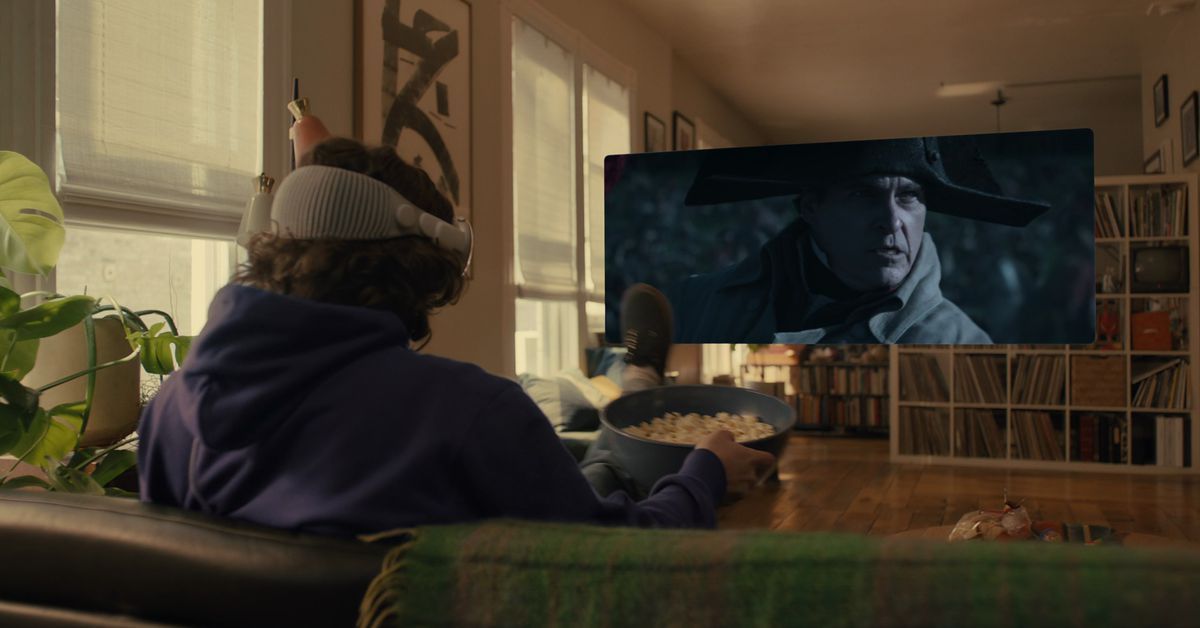The Apple Vision Pro might be a TV, but it won’t replace the TV
Apple’s Vision Pro is a TV. It’s not even out yet, but that feels well established at this point. While it can play games and do VR experiences and mimic AR through terrific feats of engineering, the use case with the most traction so far is you can strap it on your face and effectively have a 100-plus-inch 4K HDR TV set without the need to find wall space in your house.
But while it’s clear Apple has crafted a gorgeous content consumption device that should have incredible displays that could potentially replicate the quality of a high-end television like the LG C2 OLED or the Samsung QN90B, let’s be serious. This thing ain’t replacing the TV anytime soon.
Some people would claim it’s not supposed to. That it will instead be a supplement, similar to the 3D TV that returned to the scene in 2010 and disappeared a few years later because the majority of people don’t actually care that much about basketballs and arrows popping off the screen and into their vision. Like the 3D TV, the Vision Pro even requires you to wear special glasses and has limited usability for those with vision issues. But also like the 3D TV, it will face massive content challenges. Part of the reason the 3D TV failed was because not nearly enough studios, TV channels, and sport organizations adopted it.
Apple showed off plenty of exhilarating sports examples in its carefully controlled demo, but given we can only get very select NBA games in 4K and only on DirecTV, I’m not really confident courtside 3D is just around the river bend.
So let’s focus on it just being a 2D content consumption device because it will take quite a few years for Hollywood and the sports world to catch up — even if this thing is a runaway hit and sells millions in months.
Instead of a TV in every room, you could put on the Vision Pro and have the content follow you in a little corner of your vision while you cook meals, do laundry, or shitpost online. But the Vision Pro starts at $3,499. That’s the same price as approximately six 32-inch Samsung The Frame TVs. The quality of the Vision Pro will likely be superior to the 32-inch Samsung TV, but one can be enjoyed by anyone in the home and blends in on the wall like art. The other is a pound of face computer your neck and shoulders must carry from room to room and isolates you from everyone around you.
Counterpoint: Hell is watching TV with other people A massive TV screen that I can watch anywhere and the only catch is that I can’t share it with anyone? Do you really call that a catch? Look, I’m not saying that the only way to watch a great game, TV show, or movie is by yourself in complete silence with no distractions and no one interrupting to ask about the plotlines they missed. But… I remember the late ’90s and early 2000s as people started outfitting their homes with multiple TVs in separate bedrooms and how it changed what was available to watch with more specifically tailored options to suit everyone’s tastes. It may have doomed TGIF, but it proves to me that watching TV as a communal experience isn’t really what people are jonesing for. No, I don’t think the Vision Pro can eliminate all screens in your household, but anyone considering buying this iteration probably has more than one big screen set already, plus a few monitors, tablets, and laptops that are already used for solo content experiences. Not everyone wants to watch an F1 Grand Prix in the middle of the night, nor should they. And I have plenty of friends who enjoy watching the NBA, too, but I don’t invite them over every time I watch a game. We’re more than likely talking in a group chat, on Discord, or just catching up later. If Apple’s Vision Pro headset is best used as a personal TV, that doesn’t justify its hefty price tag, but it doesn’t immediately disqualify the device either. I don’t anticipate this as a device that replaces every TV in the house. But right now, I keep around multiple huge TVs that I rarely watch, just so I don’t indignify myself and everything I represent by facing the choice of either walking to another room or using a smaller screen. If I can ditch one or two of those and still have a way to get near-IMAX viewing anywhere in my home, I’m taking it. Well, I might, once it doesn’t cost $3,500. – Richard Lawler
That isolation has given people pause. Others can’t enjoy the Vision Pro’s content alongside you unless they have their own Vision Pro. We have plenty of examples of other gadgets that have similarly isolated people. From the Game Boy to the phone you might be reading this piece on, there are a lot of devices that are intended to be operated and enjoyed solo. Notably, TVs are not one of them. Televisions are typically communal devices. You like to call out the heinous antics on Netflix’s The Ultimatum to the person sitting on the couch next to you or laugh at the creepy CGI in the latest live-action adaptation of a Disney film. On the Vision Pro, that isn’t happening until you both have your own and also the Vision Pro streaming apps support watch parties. Given how long it’s taken streaming services to support watch parties on the web or set-top boxes, you’ll forgive me if I don’t see this happening at launch for most services.
But the thing really holding the Vision Pro back from replacing TVs isn’t price or weight or the inherent loneliness of using a face computer. It’s that the Vision Pro won’t support all the same media a TV can. Instead, it’s the walled garden of a phone.
To play the PS5, you wouldn’t be able to hardwire it in; instead, you’d need to use Remote Play, hope your local area network is robust enough, and pray there’s no heavy pixelation as the stream from your PS5 is heavily compressed to travel along Wi-Fi and into your headset with minimum lag. I currently occasionally play my PS5 on my Steam Deck and on my iPhone, and while it can be a good-enough experience, it is in no way as crisp or clean as when I play it on my TV. Because the Vision Pro lacks HDMI ports, I’d be stuck with the same experience there, only on a virtual 105-inch TV. That doesn’t sound great!
The same holds true for the Xbox and other cloud gaming services. Apple, notoriously, isn’t a fan of allowing cloud gaming on its iOS platform, and to get it working, web apps have to be employed. Why on earth would I want to play a lower-resolution web app version of the upcoming Starfield on a virtual 105-inch TV when I could whip the headset off, give my neck a break, and play on a TV, sans web app and severe compression?
As a gadget nerd, I know why. Because new and novel forms of content consumption are fun. I’m okay with using junky Android E Ink tablets to read books or $3,500 VR headsets to watch movies because I will happily suffer all the issues and weirdness and tradeoffs for the experience of something new and different.
Source: The Verge


